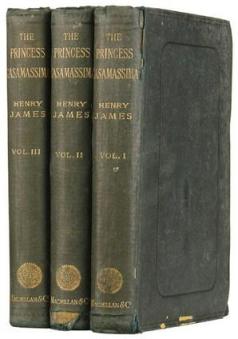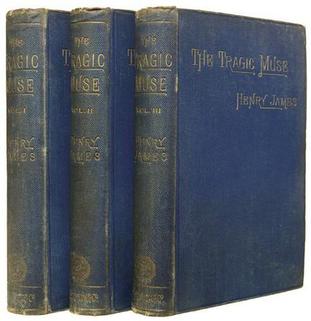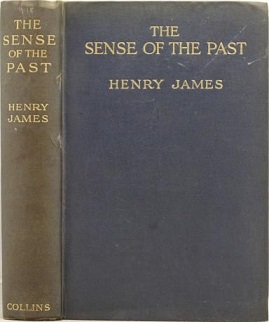
Henry James was an American-British author. He is regarded as a key transitional figure between literary realism and literary modernism, and is considered by many to be among the greatest novelists in the English language. He was the son of Henry James Sr. and the brother of philosopher and psychologist William James and diarist Alice James.

The Portrait of a Lady is a novel by Henry James, first published as a serial in The Atlantic Monthly and Macmillan's Magazine in 1880–81 and then as a book in 1881. It is one of James's most popular novels and is regarded by critics as one of his finest.
Joseph Leon Edel was an American/Canadian literary critic and biographer. He was the elder brother of North American philosopher Abraham Edel.

The Aspern Papers is a novella by American writer Henry James, originally published in The Atlantic Monthly in 1888, with its first book publication later in the same year. One of James's best-known and most acclaimed longer tales, The Aspern Papers is based on the letters Percy Bysshe Shelley wrote to Mary Shelley's stepsister, Claire Clairmont, who saved them until she died. Set in Venice, The Aspern Papers demonstrates James's ability to generate suspense while never neglecting the development of his characters.

The Princess Casamassima is a novel by Henry James, first published as a serial in The Atlantic Monthly in 1885 and 1886 and then as a book in 1886. It is the story of an intelligent but confused young London bookbinder, Hyacinth Robinson, who becomes involved in radical politics and a terrorist assassination plot. The book is unusual in the Jamesian canon for dealing with such a violent political subject. But it is often paired with another novel published by James in the same year, The Bostonians, which is also concerned with political issues, though in a much less tragic manner.

The Tragic Muse is a novel by Henry James, first published as a serial in The Atlantic Monthly in 1889–1890 and then as a book in 1890. This wide, cheerful panorama of English life follows the fortunes of two would-be artists: Nick Dormer, who throws over a political career in his efforts to become a painter, and Miriam Rooth, an actress striving for artistic and commercial success. A cast of supporting characters help and hinder their pursuits.

What Maisie Knew is a novel by Henry James, first published as a serial in The Chap-Book and in the New Review in 1897 and then as a book later that year. It tells the story of the sensitive daughter of divorced, irresponsible and narcissistic parents. The book follows the title character from earliest childhood to precocious maturity.

In the Cage is a novella by Henry James, first published as a book in 1898. This long story centers on an unnamed London telegraphist. She deciphers clues to her clients' personal lives from the often cryptic telegrams they submit to her as she sits in the "cage" at the post office. Sensitive and intelligent, the telegraphist eventually finds out more than she may want to know.
The Reverberator is a short novel by Henry James, first published as a serial in Macmillan's Magazine in 1888, and then as a book later the same year. Described by a web authority on Henry James as "a delightful Parisian bonbon," the comedy traces the complications that result when nasty but true stories about a Paris family get into the American scandal sheet of the novel's title.

The Other House is a novel by Henry James, first published as a serial in the Illustrated London News in 1896 and then as a book later the same year. Set in England, this book is something of an oddity in the James canon for its plot revolving around a murder. The novel was originally planned as a play called The Promise. James sketched a scenario for the play in 1893, but it didn't interest theater managers. In 1896 James converted the scenario into The Other House for publication in a popular weekly magazine. He converted the novel back into a play in 1909, but it again failed to be produced.

The Sense of the Past is an unfinished novel by the American author Henry James that was published in 1917, a year after James' death. The novel is at once an eerie account of time travel and a bittersweet comedy of manners. A young American trades places with a remote ancestor in early 19th-century England, and encounters many complications in his new surroundings.
Edward (Charles) Wagenknecht was an American literary critic and teacher who specialized in 19th century American literature. He wrote and edited many books on literature and movies, and taught for many years at various universities, including the University of Chicago and Boston University. He also contributed many book reviews and other writings to such newspapers as the Boston Herald, The New York Times, and the Chicago Tribune and to such magazines as The Yale Review and The Atlantic Monthly.
A Passionate Pilgrim is a novella by Henry James, first published in The Atlantic Monthly in 1871. The story was the earliest fiction that James included in the New York Edition (1907–1909) of his works. Set in England, the tale shows James' strong interest in the contrast between the Old World and the New. In fact, the difference between America and Europe erupts into open conflict in the story, which leads to an ironic ending.
Madame de Mauves is a novella by Henry James, originally published in The Galaxy magazine in 1874. The story centers on the troubled marriage of a scrupulous American wife and a far from scrupulous French husband, and is told mostly from the point of view of a male friend of the wife. The tale reflects the intense interest James took in the "international theme," especially early in his career. One of the longest fictions he had yet attempted, the smoothly narrated story shows that James was rapidly maturing in style and technique.
The Author of Beltraffio is a short story by Henry James, first published in the English Illustrated Magazine in 1884. This macabre account of desperate family infighting eventually leads to a tragic conclusion. Although the father in the story is a novelist, the tale concentrates far more on his family relationships than on his special concerns as a writer, though some of those concerns affect the outcome.

"The Real Thing" is a short story by Henry James, first syndicated by S. S. McClure in multiple American newspapers and then published in the British publication Black and White in April 1892 and the following year as the title story in the collection, The Real Thing and Other Stories published by Macmillan. This story, often read as a parable, plays with the reality-illusion dichotomy that fascinated James, especially in the later stages of his career. For the illustrator who narrates the story, the genuine article proves all too useless for his commercial purposes. The story portrays the unfortunate victims of a society in which reality and representation are closely intertwined in ways that make art a difficult project to disentangle the two.

"The Altar of the Dead" is a short story by Henry James, first published in his collection Terminations in 1895. A fable of literally life and death significance, the story explores how the protagonist tries to keep the remembrance of his dead friends, to save them from being forgotten entirely in the rush of everyday events. He meets a woman who shares his ideals, only to find that the past places what seems to be an impassable barrier between them. Although James was not religious in any conventional sense, the story shows a deep spirituality in its treatment of mortality and the transcendent power of unselfish love.
"The Great Good Place" is a short story by Henry James, first published in Scribner's Magazine in 1900. The story portrays George Dane, a harried writer who dreams of escaping to a place where he can rest and recover before returning to the grind of his overloaded life. Dane gets his wish, at least in a memorable fantasy.
Mrs. Medwin is a short story by Henry James, first published in Punch in 1900. The story slyly satirizes fashionable society in fin-de-siècle England. The central characters are an American brother and sister who both entertain and live off this society, which has grown bland and bored and almost exhausted.

The Death of the Lion is an 1894 short story by Henry James.










